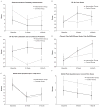A mind-body program for older adults with chronic low back pain: results of a pilot study
- PMID: 20021599
- PMCID: PMC2849802
- DOI: 10.1111/j.1526-4637.2009.00746.x
A mind-body program for older adults with chronic low back pain: results of a pilot study
Abstract
Objectives: Determine the impact of an 8-week mindfulness meditation program on disability, psychological function, and pain severity in community-dwelling older adults with chronic low back pain, and to test the education control program for feasibility.
Design: Randomized controlled trial. Participants. Forty community-dwelling older adults with moderate low back pain or greater for at least the previous 3 months. Intervention. Participants were randomized to an 8-week meditation program or an 8-week education control program.
Outcome measures: Disability, psychological function, and pain severity were assessed. The same measures were obtained for both groups at baseline, at the end of the program, and 4 months after program completion.
Results: Sixteen participants (80%) completed the meditation program and 19 (95%) completed the education program. Both the meditation and control group improved on measures of disability, pain, and psychological function, both at program completion and 4-month follow-up. The differences between the two groups did not reach statistical significance. The meditation group practiced mindfulness meditation a mean of 5 days/week (range 1-7) and mean of 31 minutes/session (range 22-48). At 4 months follow-up 14/16 (88%) participants continued to meditate.
Conclusion: Both the intervention group and the education control group improved on outcome measures suggesting both programs had a beneficial effect. Participants continued to meditate on 4-month follow-up. The control program was feasible but not inert. Piloting the control program in mind-body research can inform the design of larger clinical trials.
Conflict of interest statement
There are no financial or other conflicts of interests to declare by Drs. Morone, Rollman, Moore, Qin or Weiner.
Figures


References
-
- Number of older Americans. [accessed September 2008]. Available at: http://www.agingstats.gov/agingstatsdotnet/Main_Site/Data/2008_Documents....
-
- Helme RD, Gibson SJ. The epidemiology of pain in elderly people. Clin Geriatr Med. 2001;7:417–31. - PubMed
-
- Lawrence RC, Helmick CG, Arnett FC, et al. Estimates of the prevalence of arthritis and selected musculoskeletal disorders in the United States. Arthritis Rheum. 1998;41:778–99. - PubMed
-
- Bressler HB, Keyes WJ, Rochon PA, Badley E. The prevalence of low back pain in the elderly. A systematic review of the literature. Spine. 1999;24:1813–19. - PubMed
-
- Weiner DK, Kim YS, Bonino P, Wang T. Low back pain in older adults: Are we utilizing healthcare resources wisely? Pain Med. 2006;7:143–50. - PubMed

